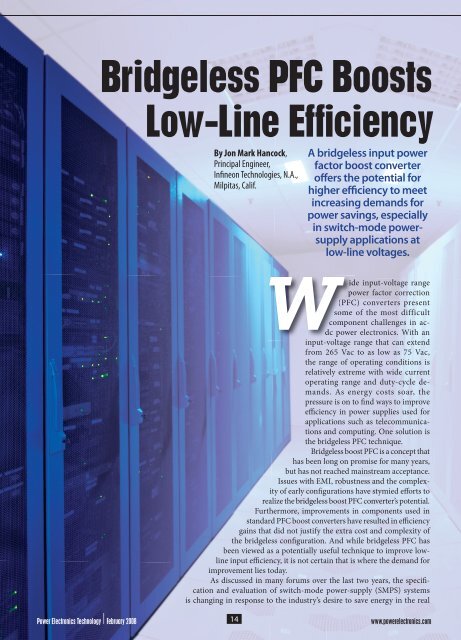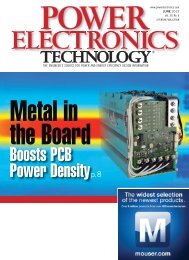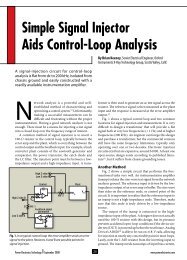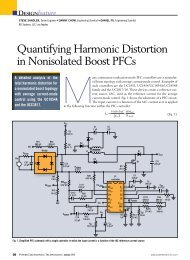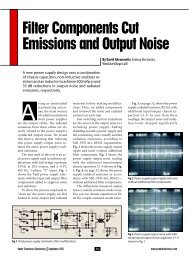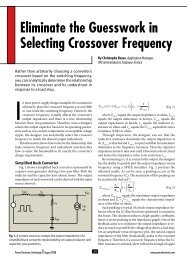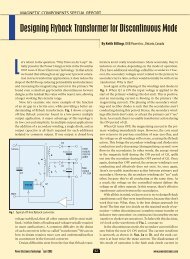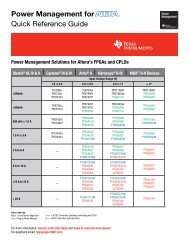Bridgeless PFC Boosts Low-Line Efficiency - Power Electronics
Bridgeless PFC Boosts Low-Line Efficiency - Power Electronics
Bridgeless PFC Boosts Low-Line Efficiency - Power Electronics
Create successful ePaper yourself
Turn your PDF publications into a flip-book with our unique Google optimized e-Paper software.
<strong>Bridgeless</strong> <strong>PFC</strong> <strong>Boosts</strong><br />
<strong>Low</strong>-<strong>Line</strong> Effi ciency<br />
By Jon Mark Hancock,<br />
Principal Engineer,<br />
In neon Technologies, N.A.,<br />
Milpitas, Calif.<br />
A bridgeless input power<br />
factor boost converter<br />
o ers the potential for<br />
higher e ciency to meet<br />
increasing demands for<br />
power savings, especially<br />
in switch-mode powersupply<br />
applications at<br />
low-line voltages.<br />
ide input-voltage range<br />
power factor correction<br />
(<strong>PFC</strong>) converters present<br />
some of the most difficult<br />
component challenges in acdc<br />
power electronics. With an<br />
input-voltage range that can extend<br />
from 265 Vac to as low as 75 Vac,<br />
the range of operating conditions is<br />
relatively extreme with wide current<br />
operating range and duty-cycle demands.<br />
As energy costs soar, the<br />
pressure is on to fi nd ways to improve<br />
effi ciency in power supplies used for<br />
applications such as telecommunications<br />
and computing. One solution is<br />
the bridgeless <strong>PFC</strong> technique.<br />
<strong>Bridgeless</strong> boost <strong>PFC</strong> is a concept that<br />
has been long on promise for many years,<br />
but has not reached mainstream acceptance.<br />
Issues with EMI, robustness and the complexity<br />
of early confi gurations have stymied eff orts to<br />
realize the bridgeless boost <strong>PFC</strong> converter’s potential.<br />
Furthermore, improvements in components used in<br />
standard <strong>PFC</strong> boost converters have resulted in effi ciency<br />
gains that did not justify the extra cost and complexity of<br />
the bridgeless confi guration. And while bridgeless <strong>PFC</strong> has<br />
been viewed as a potentially useful technique to improve lowline<br />
input effi ciency, it is not certain that is where the demand for<br />
improvement lies today.<br />
As discussed in many forums over the last two years, the specifi -<br />
cation and evaluation of switch-mode power-supply (SMPS) systems<br />
is changing in response to the industry’s desire to save energy in the real<br />
<strong>Power</strong> <strong>Electronics</strong> Technology February 2008 14<br />
www.powerelectronics.com<br />
802PET20.indd 14 2/12/2008 9:36:58 AM
world. Traditionally, effi ciency has normally been specifi ed<br />
at full load for high- and low-line ranges, but now a more<br />
realistic approach is being widely adopted, looking at the<br />
behavior of the system and its effi ciency in the range where<br />
the SMPS usually operates.<br />
VIN [1] Th is means that for redundant<br />
power systems such as computing servers and telecom<br />
power, it is now realized that effi ciency in the 10% to 50%<br />
range must be considered along with full load behavior, as<br />
shown in Fig. 1.<br />
As a result, system manufacturers such as IBM are<br />
changing the focus of how they specify and procure power.<br />
Th is change has been driven by customers with limited abilities<br />
to expand data centers because of power and cooling<br />
capacity. While the best of contemporary<br />
conventional <strong>PFC</strong> designs can just meet<br />
such current voluntary standards as<br />
Green Grid and ClimateSavers, more<br />
stringent future requirements may force<br />
designers to look for new solutions. A<br />
bridgeless <strong>PFC</strong> input confi guration can<br />
help support these requirements, although<br />
it may require some rethinking<br />
of design methodology and optimization<br />
methods.<br />
Conventional <strong>PFC</strong><br />
Versus <strong>Bridgeless</strong><br />
The well-known single-boost <strong>PFC</strong><br />
rectifi er confi guration shown in Fig. 2a<br />
consists of a full-bridge rectifi er input,<br />
which provides a rectified pulsating<br />
half-sine waveform applied to a boost<br />
converter consisting of switch S1, boost<br />
inductor L1 and boost rectifier D1,<br />
which charges a bulk rectifi er capacitor,<br />
“bus cap.”<br />
Fig. 2b shows the basic bridgeless<br />
boost concept, patented in 1983. [2] Th is<br />
variant shows a dual-winding inductor<br />
on one core. With alternating halfsine<br />
polarity on the ac line voltage, the<br />
MOSFETs alternate between operating<br />
as a low-frequency half-wave rectifi er<br />
diode connecting the ac line voltage to<br />
the bulk bus negative terminal. It also<br />
operates as a high-frequency chopper<br />
driving the respective boost inductor winding and boost<br />
rectifi er diode.<br />
Th is confi guration reduces the number of semiconductor<br />
devices in the inductor charging-current path from three to<br />
two, lowering conduction loss by about one diode-junction<br />
voltage drop (V F ). Th e MOSFETs conduct as either a highfrequency<br />
switch or a low-frequency half-wave rectifi er<br />
operating on alternate ac half cycles. As a result, some of<br />
the power losses normally handled by the ac bridge rectifi er<br />
V IN<br />
www.powerelectronics.com 15<br />
<strong>Power</strong> <strong>Electronics</strong> Technology February 2008<br />
<strong>Efficiency</strong> (%)<br />
95<br />
90<br />
85<br />
80<br />
75<br />
70<br />
Latest SMPS<br />
Proposed silver level<br />
Proposed gold level<br />
Typical SMPS<br />
65<br />
10 20 35 50 75 100<br />
Load (% rated power-supply output)<br />
Fig. 1. In some computing and telecom applications, power supplies<br />
are now expected to meet targets for effi ciency in the 10% to 50%<br />
load range, while still achieving high effi ciency at full load. [1]<br />
Boost<br />
inductor<br />
(a) Conventional boost <strong>PFC</strong> configuration<br />
L1a<br />
L1b<br />
Dual-winding<br />
boost inductor<br />
(b) Basic bridgeless boost <strong>PFC</strong> configuration<br />
Boost rectifier<br />
L1 IL D1<br />
D<br />
D1<br />
I L1a<br />
S1<br />
S1 S2<br />
Bus<br />
cap<br />
D2<br />
I L1b<br />
Vdc OUT<br />
+<br />
Load<br />
Vdc OUT<br />
Fig. 2. A comparison of the conventional single-boost <strong>PFC</strong> rectifi er confi gurations: The basic<br />
bridgeless boost <strong>PFC</strong> confi guration employs a full-bridge rectifi er, inductor, power MOSFET<br />
switch and bus capacitor (a). The conventional confi guration includes a dual-winding<br />
inductor on a single core, along with two power MOSFET switches, diodes D1 and D2, and<br />
an output capacitor (b).<br />
Load<br />
are now transferred to the power MOSFETs, potentially<br />
resulting in higher junction temperatures, which aff ects<br />
the overall MOSFET size.<br />
Deterring the industry’s adoption of the bridgeless <strong>PFC</strong><br />
are several innate confi guration characteristics. Because<br />
of the inductor confi guration and lack of a low-frequency<br />
path to the output, there is a relatively high common-mode<br />
switching voltage present at the bulk negative connection<br />
and no low-frequency path to the ac input. Th is can result<br />
in relatively high common-mode EMI because of the<br />
802PET20.indd 15 2/12/2008 9:37:03 AM<br />
I DC<br />
I DC
charge and discharge of normal parasitic<br />
capacitances associated with the converter’s<br />
physical construction.<br />
Sensing the input voltage and input current<br />
usually require isolated circuits due to<br />
the high-frequency potential between the<br />
ac input and output ground reference. It<br />
may even be necessary to use dual currentsense<br />
transformers (for switch and inductor<br />
current), while also applying rectifi ed<br />
half-sine voltage sensing on the primary. [3]<br />
Th is example makes no provision for precharging<br />
the bulk capacitance or dealing<br />
with surge stress encountered during cycle<br />
skip or low-line to high-line jumps.<br />
Hall Eff ect Current Sensing<br />
A modifi ed version of this confi guration<br />
was used to develop an experimental<br />
high-effi ciency bridgeless <strong>PFC</strong> front end<br />
in coordination with Isle Engineering,<br />
an independent consulting company in<br />
Ilmenau, Thuringia, Germany, up to a<br />
maximum output power level of 1500 W. [4]<br />
Fig. 3 shows the basic confi guration. Some<br />
of the design issues for this bridgeless <strong>PFC</strong><br />
were addressed with specifi c techniques to<br />
optimize effi ciency to the greatest extent<br />
possible, with a target value of 99% at full<br />
load. In practice, these eff orts made it possible<br />
to realize about 98.8% effi ciency at full<br />
output in the fi nished design.<br />
First, input-voltage sensing was eliminated by using a<br />
<strong>PFC</strong> controller based on single-cycle control, as pioneered<br />
by Smedly and Cuk. [5] Th is does not require input-voltage<br />
sensing and <strong>PFC</strong> controllers are available from vendors<br />
that use this technique. [6] Th e LAH25 wideband Hall Eff ect<br />
sensor with isolated data outputs accomplishes current<br />
sensing on the ac primary aft er the bulk precharge diodes<br />
D3 and D4. Th is component avoids the losses associated<br />
with resistive sensing and eliminates the need for sensing<br />
transformers in high-speed switching paths.<br />
Th e boost rectifi er diodes are silicon carbide, merged<br />
PiN Schottky types that combine the characteristics of<br />
Schottky and p-n diodes with nearly negligible reverse<br />
recovery charge (Q RR ) capacitive losses and low forward<br />
drop. The switching MOSFETs were selected for lowenergy-specifi<br />
ed output capacitance (C OSS ) to minimize<br />
turn-on loss and are capable of near zero-voltage switching<br />
turn-off with very low losses due to their output capacitance<br />
nonlinearity. [7]<br />
Th e control arrangements for this confi guration are<br />
somewhat complex, and a zero-crossing detector and<br />
driver-steering logic located aft er the PWM output of the<br />
<strong>PFC</strong> controller steer the driver signal to either S1 or S2.<br />
Th is depends on the ac-voltage input phase while driving<br />
V IN<br />
bridgeless pfc<br />
the other MOSFET as a synchronous rectifi er. A fl yback<br />
bias supply, using an integrated controller and FET, provides<br />
±12 V for the <strong>PFC</strong> controller and Hall Eff ect sensor<br />
module, which is part of the overall losses accounted for<br />
in the effi ciency measurement.<br />
Th is development was successful in demonstrating a<br />
range of techniques to achieve quite high effi ciency in the<br />
<strong>PFC</strong> front end, but it was limited to a high-line confi guration<br />
due to the lack of conventional heatsinks, and suff ers<br />
from the common-mode EMI issues of the original confi<br />
guration. Derivations of another proposed confi guration<br />
address these issues.<br />
Half-Wave Design<br />
A bridgeless half-wave rectifi ed dual boost <strong>PFC</strong> was<br />
proposed by Barbi and Souza that used insulated-gate bipolar<br />
transistors (IGBTs) with a nondissipative snubber to<br />
reduce switching losses. [8] IGBTs lack the functional body<br />
diode of MOSFETs, so diodes must accomplish input halfwave<br />
rectifi cation (slow-recovery diodes are suffi cient).<br />
A modifi cation of this design was adapted to MOSFETs,<br />
removing the nondissipative snubbers and adding diodes<br />
for bulk capacitor precharge (Fig. 4).<br />
Diodes D5 and D6 are low-frequency half-wave rectifi ers,<br />
www.powerelectronics.com 17<br />
<strong>Power</strong> <strong>Electronics</strong> Technology February 2008<br />
LAH25<br />
ZCD<br />
driver<br />
logic<br />
Isolated input current sense<br />
using Hall Effect sensor<br />
Dual-winding<br />
boost inductor<br />
L1a<br />
L1b<br />
<strong>Bridgeless</strong> boost <strong>PFC</strong> with bulk precharge, Hall current sense<br />
D3<br />
D1<br />
I L1a<br />
D4<br />
D2<br />
S1 S2<br />
I L1b<br />
Vdc OUT<br />
Fig. 3. A bridgeless boost <strong>PFC</strong> with bulk precharge and a Hall current sensor realizes about<br />
98.8% effi ciency at full output.<br />
V IN<br />
D3<br />
D5<br />
D6<br />
D4<br />
NTC<br />
L1<br />
L2<br />
Current<br />
sense<br />
D1<br />
I L1<br />
D2<br />
S1 S2<br />
<strong>Bridgeless</strong> boost <strong>PFC</strong> with half-wave rectifier and bulk bus precharge<br />
I L2<br />
+<br />
+<br />
Load<br />
Vdc OUT<br />
Fig. 4. A bridgeless boost <strong>PFC</strong> with half-wave and bulk bus precharge removes the nondissipative<br />
snubbers and adds diodes for bulk capacitor precharge.<br />
802PET20.indd 17 2/12/2008 9:37:04 AM<br />
Load<br />
I DC<br />
I DC
Losses (W)<br />
40<br />
30<br />
20<br />
10<br />
bridgeless pfc<br />
Conduction losses<br />
Capacitive losses CP Series<br />
CoolMOS CP 600 V Series<br />
0<br />
0 50 100<br />
Spec RDS (m)<br />
ON<br />
150 200<br />
(a) Loss minimal for 800 W, 130 kHz, 90 Vac<br />
Fig. 5. MOSFET losses in the boost <strong>PFC</strong> vary with the power MOSFET R DSON as demonstrated with a <strong>PFC</strong> stage configured for 800-W output<br />
(full load), switching at 130 kHz. For the case where input voltage is 90 Vac, conduction loss (shown in yellow) and switching loss (shown in<br />
red) are balanced and minimized at an R DSON of 30 mΩ (a). When input voltage is raised to 208 Vac , lowest losses occur with higher R DSON ,<br />
and reduced capacitive loss (b).<br />
alternately making a low-frequency connection between the<br />
ac line and the bulk negative connection. Diodes D3 and D4<br />
provide the bulk precharge function during startup and in<br />
SIP AD1 6/1/07 2:06 PM Page 1<br />
cycle skip or brownout recovery. The configuration of D3,<br />
D4, D5 and D6 forms a bridge and can be implemented<br />
Losses (W)<br />
0<br />
0 50 100<br />
Spec RDS (m)<br />
ON<br />
150 200<br />
(b) Loss minimal for 800 W, 130 kHz, 208 Vac<br />
with standard slow-recovery ac bridge rectifiers.<br />
Chopper switches S1 and S2 drive inductors L1 and L2<br />
on alternate line half cycles. This is a potential cost disadvantage<br />
compared with the combined coupled-inductor<br />
structure of the last example. However, by using separate<br />
cores high-frequency excitation and heating occurs for each<br />
inductor only during every other ac half cycle, providing<br />
thermal benefits that reduce inductor size and cost. Some<br />
half-wave rectification still occurs through the inductor<br />
and the MOSFET body diode, shown in Fig. 4, because<br />
they’re not the primary half-wave rectifier used for other<br />
configurations.<br />
The majority of current flows in diodes D5 and D6,<br />
slow-recovery half-wave rectifiers. This has the effect of<br />
reducing the power dissipation and maximum junction<br />
temperature in the MOSFET switches, which lowers their<br />
effective operating on-resistance (R DSON ). MOSFET R DSON<br />
can double between room temperature and maximum<br />
operating temperatures, so a lower junction temperature<br />
lowers conduction losses.<br />
In this configuration, current sense is at the same potential<br />
as the output load return and controller ground,<br />
allowing some flexibility in measurement technique and<br />
including the use of conventional resistive in-line sensing.<br />
Of course, resistive sensing increases the losses, but by<br />
how much?<br />
Let’s consider an example of a 1-kW output converter, assuming<br />
a nominal efficiency (η) of 90% and a low-input-line<br />
voltage of 90 Vac. Let’s assume that for the controller being<br />
used, we need 26 mΩ to generate the required maximum<br />
sense voltage. The peak input current is:<br />
(Eq. 1)<br />
<strong>Power</strong> <strong>Electronics</strong> Technology February 2008 18<br />
www.powerelectronics.com<br />
40<br />
30<br />
20<br />
10<br />
I<br />
PK<br />
POUT<br />
×<br />
=<br />
η×<br />
V<br />
IN MIN<br />
Conduction losses<br />
Capacitive losses CP Series<br />
CoolMOS CP 600 V Series<br />
2<br />
= 17. 64 A.<br />
The sense resistor power dissipation is:<br />
802PET20.indd 18 2/12/2008 9:37:06 AM
P<br />
SENSE<br />
2<br />
IPK<br />
= RSENSE<br />
⎛ ⎞<br />
⎜ ⎟ × = 4. 365 W. (Eq. 2)<br />
⎝ 2 ⎠<br />
This amounts to 0.5% efficiency loss at low line. However,<br />
if normal operation at high line and cost are a greater concern,<br />
at 208 Vac the total P SENSE loss is only 0.755 W, less than<br />
0.1%. This may be a tolerable tradeoff. Note that eliminating<br />
the extra diode drop of the conventional bridge diode even<br />
at high line may save 5 W to 8 W.<br />
Examining this bridgeless <strong>PFC</strong> configuration, it could<br />
appear that the component count is double that of the conventional<br />
<strong>PFC</strong> configuration in Fig. 2a. In reality, with the<br />
same total MOSFET and boost rectifier silicon “budget” in<br />
either configuration, a higher total efficiency can be achieved<br />
with the bridgeless configuration. And considering the<br />
targets shown in Fig. 1, achieving higher efficiency at the<br />
lower power ranges is well served by splitting up the switch<br />
and diode budget between the dual boost phases.<br />
To understand why this is so, examine the selection of the<br />
MOSFETs based on a conventional boost <strong>PFC</strong> that delivers<br />
the lowest total losses at full load and low-line ac. An Excel<br />
workbook was used to do this, with some assumptions translated<br />
from the data sheet to the application (Fig. 5a).<br />
Fig. 5 shows an 800-W output <strong>PFC</strong> application, with a<br />
net input to output efficiency of 85%, which is used to factor<br />
up the required input power. The switching frequency<br />
bridgeless pfc<br />
is 130 kHz, with an input voltage of either 90 Vac in Fig.<br />
5a or 208 Vac in Fig. 5b. The x axis is the nominal R DSON<br />
specification, but this is not used for calculation; instead,<br />
the R DSON is normalized to 105°C for the calculation of<br />
conduction losses.<br />
Since turn-off losses can be made nearly negligible with<br />
super-junction MOSFETs [7] , the focus for dynamic losses is<br />
on C OSS discharge at turn-on, an unavoidable loss in hardswitching<br />
circuits. With conventional diodes, this loss might<br />
be nearly swamped out by the Q RR and C OSS of the boost<br />
rectifier diode. With modern silicon carbide and even silicon<br />
ultrafast diodes, the output capacitance of the MOSFETs can<br />
play a dominant role in losses. [9]<br />
Looking at Fig. 5a, the minimum of the loss curve occurs<br />
for a specified R DSON of 25 mΩ to 30 mΩ. At this point, at<br />
full load and low line, the conduction and switching losses<br />
are balanced and minimized. This low resistance would take<br />
two 75-mΩ TO-247 MOSFETs in parallel to achieve. This<br />
may not be the best way to achieve efficiency, particularly<br />
if we consider the bridgeless option. Those switching losses<br />
due to C OSS capacitance will be there regardless of the load<br />
current or line voltage.<br />
Considering that the bridgeless option can save 5 W to 8<br />
W or more in conduction losses, we can take that savings into<br />
account in derating the conduction performance requirement<br />
for the MOSFETs. Moving on the loss line to the right,<br />
Take a look at our broad offering of quality<br />
power modules and fi nd out why Bel is now<br />
the preferred source for dc-dc converters.<br />
Finally, you can get cost effective products<br />
in industry standard form factors without<br />
sacrifi cing performance. To learn more<br />
about how Bel can help you power your<br />
next system, visit us at www.belpower.com.<br />
High Effi ciency <strong>Power</strong> Modules<br />
www.belpower.com • 1-800-BELFUSE<br />
Isolated Converters-Single & Dual Output<br />
•1/16, 1/8, 1/4, 1/2 Bricks up to 120A<br />
Bus Converters-4:1, 5:1, 6:1 Fixed Ratios<br />
•1/16, 1/8, 1/4 Bricks up to 500W<br />
VRMs-Solutions for most Microprocessors<br />
•Up to 150A Output; Goldfi nger and TH<br />
Non-Isolated POL Modules-Boost, Buck<br />
and Inverting<br />
•1A to 150A Output; Vertical Mount or SMT<br />
power PE 4-30-07.indd 1 6/27/07 12:14:13 PM<br />
www.powerelectronics.com 19<br />
<strong>Power</strong> <strong>Electronics</strong> Technology February 2008<br />
802PET20.indd 19 2/12/2008 9:37:08 AM
idgeless pfc<br />
the losses increase as a function of conduction loss, so it’s<br />
possible to move over to the right, where conduction losses<br />
are up by 5 W to 7 W, and write that off due to the conduction<br />
loss improvement of the bridgeless configuration.<br />
Most importantly, shifting to a single 75-mΩ, instead of<br />
a 25-mΩ to 30-mΩ MOSFET cuts C switching losses in<br />
OSS<br />
half. Therefore, switching loss reduction at all other load<br />
ranges and line voltages will be significant. This is shown in<br />
Fig. 5b for operation at full load at the SMPS normal operating<br />
208-Vac input, where the optimum MOSFET choice<br />
would appear to be around 100-mΩ. In fact, if you have that<br />
so-called “optimum” conventional MOSFET of 25 mΩ to<br />
30 mΩ for low-line performance in a conventional <strong>PFC</strong><br />
circuit, the total losses at full load are doubled for the<br />
MOSFET, due to higher C switching loss when operating<br />
OSS<br />
at 208 Vac. The loss is even worse at 50% load and below.<br />
PETech<br />
References<br />
1. Janick, J., “IBM Technology and Solutions,” IBM <strong>Power</strong><br />
and Cooling Symposium, October 2007, Raleigh, N.C.,<br />
proceedings at www-03.ibm.com/procurement.<br />
2. Mitchell, D.M., “AC-DC Converter Having an Improved<br />
<strong>Power</strong> Factor,” U.S. Patent 4,412,277, Oct. 25, 1983.<br />
3. Moriconi, U., “A <strong>Bridgeless</strong> <strong>PFC</strong> Configuration Based<br />
CKE-PET on L4981 7-06 <strong>PFC</strong> 12/27/07 Controller,” 10:10 Application AM Page Note 1AN<br />
1606,<br />
REPLACEMENTS<br />
FOR MANY<br />
FUJI DIODES<br />
AVAILABLE<br />
1 kV to 300 kV<br />
Fast Recovery<br />
down to 35nS<br />
Average Forward<br />
Current up to<br />
10 Amps<br />
HVCA diodes are ideal for use<br />
in high voltage power supplies<br />
and multipliers found in<br />
medical equipment and<br />
instrumentation. They<br />
are also well-suited for<br />
aerospace, military,<br />
automotive, down hole and<br />
high temperature applications<br />
and X-ray equipment used<br />
for medical, dental,<br />
industrial and<br />
security purposes.<br />
HVCA<br />
P.O. Box 848, Farmingdale, NJ 07727<br />
(732) 938-4499 (732) 938-4451 FAX<br />
e-mail: info@hvca.com www.hvca.com<br />
STMicroelectronics, November 2002.<br />
4. Hancock, J., “Meeting the Challenge for Offline SMPS<br />
Through Improved Semiconductor Current Density,”<br />
IBM <strong>Power</strong> and Cooling Symposium, 2005, proceedings<br />
at www-03.ibm.com/procurement.<br />
5. Smith, K.M., Jr.; Lai, Z.; and Smedley, K.M., “A New PWM<br />
Controller with One-Cycle response,” IEEE Transactions<br />
on <strong>Power</strong> <strong>Electronics</strong>, Volume 14, Issue 1, January 1999,<br />
pp. 142-150.<br />
6. Lu, B.; Brown, R.; and Soldano, M., “<strong>Bridgeless</strong> <strong>PFC</strong><br />
Implementation Using One Cycle Control Technique,”<br />
IEEE Applied <strong>Power</strong> <strong>Electronics</strong> Conference (APEC) 2005<br />
proceedings, pp. 812-817.<br />
7. Bjoerk, F.; Hancock, J.; and Deboy, G., “CoolMOS CP:<br />
How to Make Most Beneficial Use of the Latest Generation<br />
of Super Junction Technology Devices,” AN-CoolMOS<br />
CP-01, www.infineon.com.<br />
8. Souza, A.F., and Barbi, I., “High <strong>Power</strong> Factor Rectifier<br />
with Reduced Conduction and Commutation Losses,’’<br />
International Telecommunication Energy Conference<br />
(INTELEC) proceedings, June 1999, session 8, paper 1.<br />
9. Lu, B.; Dong, W.; Shao, Q.; and Lee, F., “Performance<br />
Evaluation of CoolMOS and SiC Diode for Single Phase<br />
<strong>Power</strong> Factor Correction Applications,” IEEE APEC 2003<br />
proceedings.<br />
Minisens<br />
FHS Current<br />
transducer<br />
Minisens is taking miniaturization to the next level as it<br />
is a fully fledged isolated current transducer including<br />
magnetic concentrators in an IC SO8 size.<br />
• Non-contact, no insertion<br />
losses<br />
• Isolation provider<br />
• Attractive price<br />
• Flexible design to measure<br />
2-70 A RMS<br />
• +5V power supply<br />
• Access to voltage reference<br />
• Ratiometric or fixed gain and<br />
offset<br />
• Standby mode pin<br />
• Dedicated additional fast output<br />
for short circuit detection<br />
• High performance gain and<br />
offset thermal drifts<br />
www.lem.com<br />
At the heart of power electronics<br />
<strong>Power</strong> <strong>Electronics</strong> Technology February 2008 20<br />
www.powerelectronics.com<br />
802PET20.indd 20 2/12/2008 9:37:09 AM


